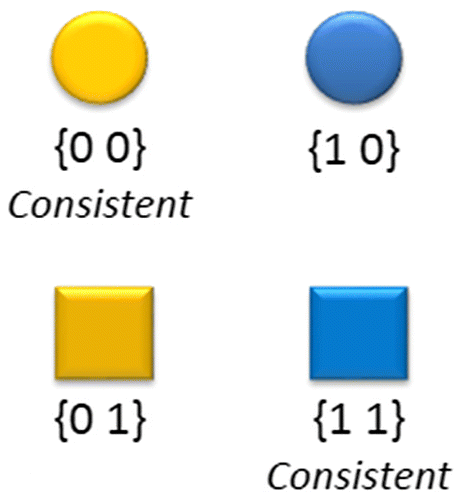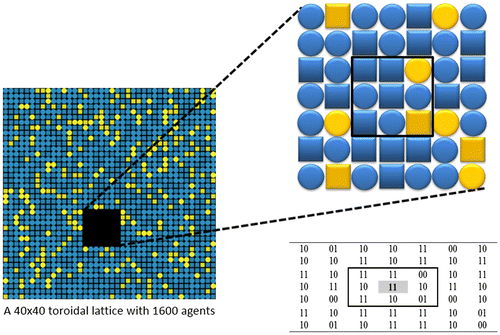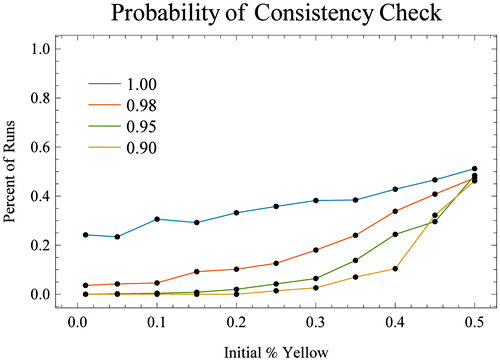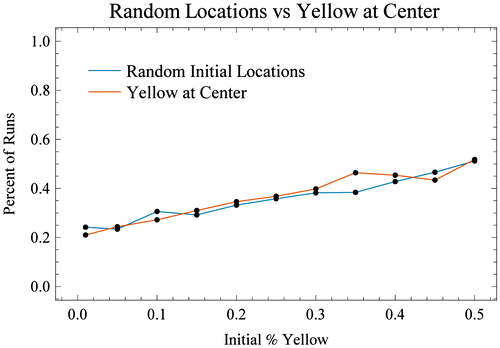Abstract
The present paper describes an agent-based model of indirect minority influence. It examines whether indirect minority influence can lead to social change as a function of cognitive rebalancing, a process whereby related attitudes are affected when one attitude is changed. An attitude updating algorithm was modelled with minimal assumptions drawing on social psychology theories of indirect minority influence. Results revealed that facing direct majority influence, indirect minority influence along with cognitive rebalancing is a recipe for social change. Furthermore, indirect minority influence promotes and maintains attitudinal diversity in local ingroups and throughout the society. We discuss the findings in terms of social influence theories and suggest promising avenues for model extensions for theory building in minority influence and social change.
Introduction
Indirect minority influence has been studied in social psychology over the past half century (Crano, Citation2001; David & Turner, Citation2001; Martin & Hewstone, Citation2008; Moscovici, Citation1976, Citation1980; Nemeth, Citation1986; Pérez & Mugny, Citation1996; Prislin & Crano, Citation2012). Indirect minority influence refers to a minority’s influence on majority attitude change on indirect or related issues, even though the indirect issue was never discussed in the direct (i.e., focal) minority communication (Alvaro & Crano, Citation1997; De Dreu & De Vries, 1993; De Dreu & De Vries, Citation1996; Wood et al., Citation1994). Moscovici (Citation1976) viewed minority dissenters as frequent, perhaps major catalysts of social change, and assumed that if minority dissenters successfully influenced the majority’s attitude toward the minority’s position, they potentially could change group norms and, by extension, an entire society. However, indirect minority influence’s role in social change has remained conjectural, because the primary methodology in social psychology cannot adequately deal with this cross-level causal link. Whereas attitude change is an intra- and inter-individual phenomenon, social change is a global-level, societal process whereby a group adopts a new attitude or idea that eventually becomes accepted as normative (Moscovici, Citation1976). In this research, we use agent-based modeling to establish the cross-level link between indirect minority influence and social change.
Indirect minority influence
Social psychological mechanisms for minority influence were most prominently proposed by Moscovici (Citation1976, 1980, 1985; Moscovici & Faucheux, Citation1972). Conversion theory (Moscovici, Citation1980) contrasts the differences underpinning the motivational and cognitive processes elicited when people encounter disagreement from members of majority and minority groups. Because the majority controls resources or power, adopting the prevailing attitude can be directly rewarding. Individuals may change attitudes to comply with the group’s consensus by comparing their own attitude to the prevailing one for some focal issue, without closely elaborating the majority’s arguments.
Conversely, when an individual or group breaks group attitudinal unanimity, group members take notice of this salient event and the nascent idea captures attention. Even though ideas in minority positions are not immediately viewed as correct, their arguments may be scrutinized in-depth. Because contemplation takes time, Moscovici argued, belief validation results in delayed focal attitude change.
For minority positions to be considered carefully, they must be consistent. In Moscovici, Lage and Naffrechoux (Citation1969)’s blue-green study, participants were shown a series of identical blue slides and asked to report the color of each. When two minority confederates consistently stated green (vs. inconsistently stating both blue and green), more participants answered that the slide was green. We often find that people do not immediately see the validity of a minority’s views even when their view is correct (e.g., Copernican heliocentrism). However, if the minority’s view is coherent and presented consistently, it may capture the majority’s attention.
Moscovici found that minority opinions were particularly influential on indirect attitudes (Moscovici et al., Citation1969; see also Clark, Citation1990; Wood et al., Citation1994). However, conversion theory did not persuasively explain how indirect minority influence occurs, why minority-induced delayed change often failed to happen, and the relationship between immediate indirect influence and delayed direct influence. For example, if delayed direct influence is based on the reasoning that contemplation takes time, why and how does immediate indirect change happen?
Later research continued to find attitude change on related issues when people processed minority opinions (Brandstätter et al., Citation1991). Meta-analysis indicated that minority, as opposed to majority influence, is greater on related than on focal issues (Wood et al., Citation1994). Theoretical explanations of indirect minority influence was pursued intensely, including the Dual-Role Model (DRM: De Dreu & De Vries, Citation1996; De Vries et al., Citation1996), Self-Categorization Theory (SCT: Abrams & Hogg, Citation1990; David & Turner, Citation2001), and the Source-Context Elaboration Model (SCEM: Martin & Hewstone, Citation2008). These theories provide only partial explanations of indirect minority influence processes – DRM and SCEM explain how and by whom a minority can exert immediate indirect influence, but not how a minority can produce delayed direct influence, or how attitude change on a related issue may be associated with a delayed change in a focal issue; SCT focuses primarily on the ingroup and outgroup source of minority influence. Most recently, context/categorization-leniency contract theory (CCLC: Crano, Citation2001, 2010), integrating social identity and information processing approaches, explains the full range of minority influence processes from immediate indirect to delayed direct attitude change.Footnote11
Context/categorization–leniency contract theory
Extending conversion theory and integrating existing indirect minority theories, CCLC theory explains when, why, and how immediate indirect attitude change and delayed focal attitude change occur through minority influence (Crano, Citation2010; Martin & Hewstone, 2001; Martin & Hewstone, Citation2010). CCLC theory postulates that when minority belief holders are ingroup members and their messages are not threatening to the ingroup’s identity (Abrams & Hogg, Citation2010), they may be influential due to a leniency contract, an implicit agreement that stipulates that the majority attend to a dissenting in-group minority opinion, thereby maintaining the viability and cohesion of the group as a whole. In turn, the minority implicitly accepts that a change in the focal belief is unlikely. However, even though direct focal attitude change is unlikely, the majority’s open-minded elaboration of the minority position creates cognitive pressure that can result in change of related attitudes within the same cognitive constellation, in the direction of the thrust of the minority’s argument.
Empirical tests have confirmed the effects of minority arguments on indirect attitude changes. Alvaro and Crano (Citation1996) found that participants exposed to an ingroup minority (compared to a majority or outgroup minorities) elaborated and recalled a message’s contents and changed their attitude on a related issue (gun control) that multidimensional analysis had linked to a focal issue (ban of homosexual soldiers) (Study1, Alvaro & Crano, Citation1997). Indirect influence elicited by the minority was also found when focal and related issues were reversed (Study 2, Alvaro & Crano, Citation1997). The ingroup minority achieved indirect influence when the minority was viewed as being distinctive (Alvaro & Crano, Citation1997) and when they consistently promoted their opinion over time (Crano & Alvaro, Citation1998).
Indirect attitude change may eventually lead to focal attitude change via cognitive rebalancing. Because attitudes do not exist in isolation, but rather are structurally interrelated in belief constellations, attitudes that occupy the same cognitive constellation may all be affected when one element of the set is changed or pressured (Crano & Lyrintzis, Citation2015; Gawronski & Strack, Citation2012). As indirect changes accumulate, delayed focal change can occur due to the tendency to maintain cognitive balance within the belief constellation (Crano & Chen, Citation1998; Fink & Kaplowitz, Citation1993; Judd et al., Citation1991; McGuire, Citation1990; McGuire & McGuire, Citation1991).
Although empirical tests indicate that indirect attitude change is indeed associated with delayed focal change (Crano & Chen, Citation1998), indirect minority influence on social change and the role of cognitive rebalancing have not been examined directly. Although by definition social change is a phenomenon that occurs at a societal level, research often reduces it to an individual or a small interactive group level, and considers individual attitude change or a small group’s decision in favor of an initial minority position (Levine & Tindale, Citation2015). This can be partially attributed to the limitations of the prevailing research methods in social psychology (Smith & Conrey, Citation2007). In most cases, experiments are cross-sectional, and variables are measured from individuals or small, often minimally sized groups of typically three to six members. Further, interactions among group members often are not allowed. If interactions do occur, they are limited in scope and time. These one-shot paradigms cannot capture the full range of dynamics endemic to social influence, whichoccurs simultaneously, mutually, and repeatedly.
Benefits of agent-based modeling
The limitations of prevailing social psychological methods can be partially offset by using agent-based modeling (ABM) (Jackson et al., Citation2017; Smith & Conrey, Citation2007; Vallacher et al., Citation2002). Since its advent (Conway, Citation1970; von Neumann, Citation1966), ABM has been used by some social psychologists (and researchers in related disciplines) to study a variety of social phenomena, from group formation (Axelrod, Citation1997; Gray et al., Citation2014; Schelling, Citation1971; Smaldino et al., Citation2012), through group decision-making (Kerr et al., Citation1979; Larson, Citation1997; Luhmann & Rajaram, Citation2015; Stasser, Citation1988, 1999; Stasser & Taylor, Citation1991; Stasser et al., Citation1980) and social influence (Jarman et al., Citation2015; Pulick et al., Citation2016; MacCoun, Citation2012; Monroe & Read, Citation2008; Nowak et al., Citation1990), to intergroup conflict (Vallacher et al., Citation2010). Agent-based models are simulated multi-agent systems in which multiple agents coexist and interact with each other simultaneously and mutually over time. Agent behavior is usually generated via a few simple contingency rules that capture the key theoretical elements of the social psychological process of interest. Although agents can be made at any level – neurons, individuals, groups, cultures, etc. – in most models of social psychological processes they are a simplified abstracted version of people. The key benefits of ABMs are that they can (1) bridge the micro-level of social psychological processes (e.g., intra-individual processes and interpersonal interactions) and the macro-level emergent consequences of the system as a whole, and (2) capture the dynamical, transient properties of that system (Hastie & Stasser, Citation2000; Read & Miller, Citation1998; Ron, Citation2006; Vallacher & Nowak, Citation1997). Although Galam and Moscovici (Citation1991; Galam, Citation2002) proposed mathematical and agent-based models of attitude change in groups, their model did not examine indirect minority influence. The present research represents an attempt to computationally model indirect minority influence.
Overview of the model
Here we describe an agent-based model of indirect minority influence in alignment with the appropriate guidelines for social psychological theory building (Holland, Citation2006; Miller & Page, Citation2007; Vallacher & Nowak, Citation2007). We first construct an attitude updating algorithm of (1) direct majority and (2) indirect minority influence and (3) cognitive rebalancing processes, and then implement the algorithm using NetLogo. Next, we provide simulation results that indicate how indirect minority influence can lead to social change as a function of rebalancing the structure of attitudes, and show how indirect minority influence contributes to attitudinal diversity. Further simulations explore the effects of initial minority size and location, ingroup size, biases in favor of attitude stability vs. change, and probability of minority influence on the relationship between indirect minority influence and social change.
Individual agent properties
Each agent (aj) has two attitudes; each attitude takes a binary value. The use of binary values (vs. continuous ones) is sometimes preferred for theoretical models because it more clearly reveals qualitative differences (Halpern et al., Citation2014; Mason et al., Citation2007). For convenience, one attitude is represented as color (: 0 = yellow, 1 = blue) and the other as shape (
: 0 = circle, 1 = square) (Figure ). Thus, there are four different agent states: yellow circle (aj = {0, 0}), yellow square (aj = {0, 1}), blue circle (aj = {1, 0}), and blue square (aj = {1, 1}). We regard the attitude system of an agent as internally consistent or cognitively balanced if the two attitudes take the same values. By our definition, the consistent agent states are the yellow circle and blue square.
Multi-agent systems
In our basic setup (Figure ), 1600 agents populate a 40-by-40 toroidal square-grid topology (i.e., wrapping boundaries and no empty spaces). An agent’s ingroup is defined by the eight agents in the agent’s Moore neighborhood, which are potential influence sources. In this way, the ingroup boundary of each agent varies.
An attitude updating algorithm
As depicted in Figure , in each iteration, each agent randomly selects one member of its local ingroup to be an influence source (ak). Each agent then compares a randomly selected focal attitude with that of its source agent. If the focal attitude of the source agrees with that of the agent ( =
), social influence is not initiated because the source affirms the agent’s view. However, if the focal attitudes of the source agent disagrees with that of the self agent (
≠
), disagreement draws the agent’s attention, evokes inner conflict and creates uncertainty (Festinger, Citation1954, Citation1957; Moscovici, Citation1976), motivating the agent to resolve it. How the agent responds is contingent upon the majority/minority status of the source’s attitude in the agent’s local ingroup.
Figure 3. A workflow diagram portraying out attitude updating algorithm including majority and minority influences and a cognitive rebalancing process.
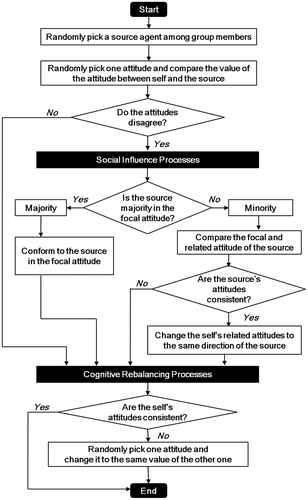
If the focal attitude of the source is held by the majority of ingroup members, the agent conforms to the source (i.e., changes that attitude to match the source; direct majority influence). Conversely, if the focal attitude is held by the minority of ingroup members, the agent examines whether the source is attitudinally consistent by comparing the values of focal and related attitudes. If the two attitudes of the source are consistent ( =
), then the agent changes the related attitudes (in this case, the other attitude) in the direction of the source’s focal attitude (immediate indirect minority influence), which in this case is a binary flip of the other attribute. However, if the attitudes are inconsistent (
≠
), the agent does not change any of its own attitudes.
Upon completion of the social influence process, the cognitive rebalancing process is initiated: these two processes are independent in the current model. All agents turn their attention to their own attitudes to rebalance their cognitive systems. Each agent j randomly picks one of the two attitudes and examines whether the chosen attitude and the other attitude have the same value. If the two attitudes are consistent, the cognitive system of the agent is balanced and the agent does not need to rebalance its cognitive system. However, if the two attitudes are inconsistent, the attitude just changed via the social influence process has introduced imbalance to the cognitive system. To rebalance, the agent tunes the randomly chosen attitude toward the other attitudes (in the case of two binary attributes, it flips the chosen one to match the other).
As a result, two forms of cognitive readjustment to the imbalanced attitude structure occur (Crano & Chen, Citation1998, p. 1440). The newly changed attitude reverts to its original position (persistence), or the newly changed attitude unbalances the belief structure, which puts pressure on the linked focal attitude to be brought into accord with the newly altered attitude (delayed focal minority influence).
Measures of social change
Social change is measured both as a dichotomous and continuous variable. In the first case it captures whether a system eventually reaches an equilibrium in which all agents hold the initially minority idea (social change = 1) or an equilibrium in which all agents hold the initially prevalent idea (no social change = 0). In the second case it is a continuous measure for social change as the cumulative proportion of agents holding the nascent attitude at each time step averaged across time. We first examine the role of cognitive rebalancing process in indirect minority influence on social change. We then explore to what degree social change dynamics are affected under a variety of model parameters (Table ).
Table 1. The model parameters used in our simulation, the values used in the main exposition, and the ranges of the parameters we swept.
Simulation results
In our basic setup we initialize the system with a randomly chosen 1% of the 1600 agents holding the nascent (i.e., minority) attitude (yellow; = 0). The shapes are initially distributed in equal proportions and randomly assigned over the population. For each combination of rules and initial conditions, we performed 500 runs of the model until (a) all the agents have the same attitude (shape and color), (b) no agents can change attitudes, or (c) 10,000 time steps (to terminate non-equilibrium runs and facilitate analysis of extremely long convergence times). At each step we track the percent of the population of each color and of each shape as well as the percent of the agents that are consistent. We summarize the results of all six combinations of majority and minority influence, and the cognitive rebalancing in Figure .
Figure 4. Results of base runs showing typical system patterns and characteristics at the individual and system level for the six combinations of majority and minority influence and cognitive rebalancing.
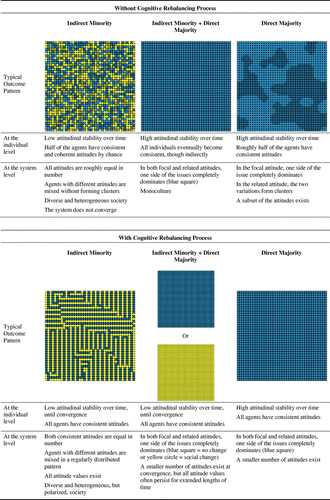
Indirect minority influence alone
The indirect minority influence process by itself always spreads a nascent attitude from 1% of the population toward 50% of a population because it increases the prevalence of whichever attitude is a local minority. Once reaching approximately half of the population, however, the nascent idea is no longer a minority, and so minority influence balances the two attitudes at the global level in a perpetual, but stochastic, churning of both color and shape. Thus, indirect minority influence alone cannot lead to social change, even though it is demonstrably instrumental in bringing an idea from obscurity to popularity (Figure ). It is worth mentioning here that although complete social change cannot occur, by bringing the nascent and prevailing attitudes to equal popularity the minority influence rule acting alone can be said to establish the new idea as socially normative for some contexts.
Figure 5. Screenshots show the growth in popularity of the nascent attitude until the system becomes stochastically mixed at roughly equal proportions.
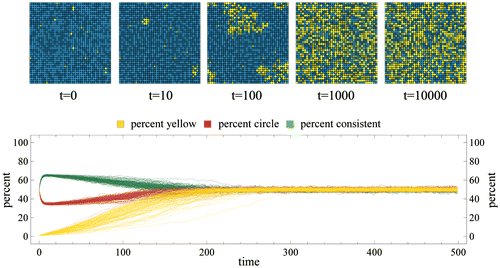
Indirect minority influence and cognitive rebalancing process
Adding the internal consistency rule to minority influence also brings the population up to a 50% distribution in every run, but the dynamical patterns are different. The agents quickly align themselves into maze-like linear arrangements of yellow circles and blue squares (Figure bottom left) because only this arrangement allows ingroups to be both consistent and split exactly in half between the two attitudes. Then it is only at the ends and corners of lines where agents can become unbalanced. Eventually these runs reach equilibrium of either all vertical or all horizontal lines of each consistent type, equally dividing the population. It also is clear that regardless of these assumptions the combined mechanisms will produce a world of roughly and stochastically equal proportions of yellow circles and blue squares.
Indirect minority influence facing majority influence
We find that in the face of majority influence (without cognitive rebalancing) minority influence cannot spread the nascent attitude. Majority influence dominates the minority influence process on the focal (color) attitude and so the system quickly converges to all blue. One surprising finding is that the system always converges to the consistent blue square outcome (Figure upper middle). It is important to recognize that the observed attitudinal consistency here results from the combined rules of majority and minority influences rather than from an imposed internal consistency rule.
Indirect minority influence and cognitive rebalancing process facing majority influence
As predicted, the indirect minority influence process in combination with cognitive rebalancing can spread an initial minority position in the face of majority influence. The combination of all three rules enables the possibility of social change, but it does not guarantee this result. As seen in Figure , the agents here are loosely clumped into temporary communities of similar agents. The dynamics of these simulations are volatile and unpredictable: the population can reach 99.8% of one color, and then swing back with an end result of the opposite color (Figure bottom graph). Although every run will eventually reach equilibrium of all yellow circles or all blue squares (Figure bottom middle), the random-walk-like behavior sometimes extends the required time to hundreds of thousands of time steps. Furthermore, although the system does not always converge to the initial minority position, in all runs we found there were always some periods of time when the initial minority position became the majority in the system. The non-equilibrium result is actually more interesting: even if a nascent idea fails to dominate in the end, it can induce widespread and long-lasting partial social change.
Figure 6. Screenshots from one run that achieved social change demonstrate the high volatility of the attitude change dynamics.
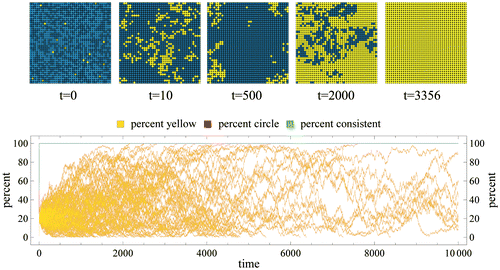
The results of setting the probability of agents rebalancing their cognitive structure of two attitudes to .90, .95, .98, and 1.0 are shown in Figure . Once again, the results confirm that cognitive rebalancing process is a key factor facilitating indirect minority influence’s ability to lead to social change. The likelihood of social change is maximized when the probability of the cognitive rebalancing is 1.0, and drops off quickly with small decreases in the cognitive rebalancing probability. This high sensitivity to cognitive rebalancing underscores its importance for minority influence’s ability to bring uncommon nascent ideas to an equal social footing.
Initial minority size
In the base model only 1% of the agents are initially set to yellow, but this is a bit misleading due to a nuance of how the rules are implemented. That number is immediately expanded in the first iteration when agents enact the cognitive rebalancing rule. Approximately half of the blue circle agents will make themselves consistent by becoming yellow circles – that’s an additional 24.25% of the agents on average (again visible in Figure ). We are interested in the relationship of the initial percent yellow and the proportion of runs resulting in social change, and for this we tracked both the initial-percent-yellow parameter and the average effective initial percent yellow (see x-axis of Figure ). Simulation results indicated that across 500 runs there is a clear and approximately linear relationship between the initial percent yellow and the proportion of runs resulting in social change. Because the individual runs are highly volatile and unpredictable, the behavior of individual runs belies this observed relationship which only becomes clear through large numbers of runs and could not be demonstrated analytically or through thought experiments.
Figure 8. This plot shows the proportion of yellow agents reached social change at the end of (left: binary social change measure) and that existed on average (right: continuous social change measure) for 500 runs when all three rules are activated.
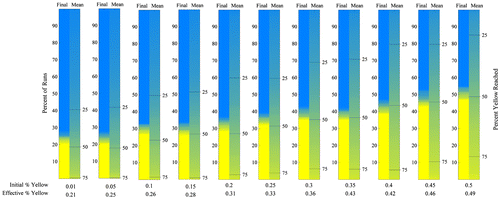
Random locations vs. community of nascent idea holders
The base model assigns a random collection of agents equaling one percent of the total population to be yellow. One may consider it a more reasonable initial configuration for all the nascent idea holders to be adjacent, i.e., part of a local community holding the new attribute. Within that community, yellow is the local majority attribute. Given that majority influence is more direct and focal, it may be expected that social change can be slightly more likely to occur when the nascent belief holders are clustered.
Although the system behavior appears quite different at first, the two configurations produce nearly indistinguishable long-term results for all rule combinations. Because only local neighborhoods are considered by the agents, the forces that move the aggregate behavior are generally invariant to regional effects such as a clump. For example, when all three rules are active majority and minority both work to quickly mix the population, dissolving the initial clump of yellow agents across the landscape. At the time scales required to reach equilibrium the initial locations of the yellow agents are irrelevant, as is evident in Figure .
Ingroup size and configuration
For the basic model we utilize the standard toroidal square-grid lattice network for agent locations and the Moore neighborhood of eight adjacent grid spaces for the ingroup. One may consider that the larger an ingroup size, the more likely social change would occur because when the ingroup size increases, the chances to have agents holding the minority belief within an ingroup also increases, thus resulting to more exposure to, and hence more influence from, minority attitude holders.
Here we vary the number of neighbors, and thus the ingroup size, through values of 3, 4, 5, 6, 7, 8, 9, 10, 16, and 26 by altering the configuration of the lattice. Furthermore, for ingroup sizes of 6, 7, and 8 we used an alternative configuration while maintaining the ingroup sizes. For example, we can achieve an ingroup size of 6 using both a two-dimensional hexagonal grid and a three-dimensional cubic grid in which corners are excluded. These alternative configurations allow us to test whether it is the number or arrangement of minority group members that makes a difference.
We find that the ingroup size has no significant effect on the aggregate long-term likelihood of achieving social change when all three rules are in operation (Figure ). Because majority and minority influence both operate upon relative popularity the effects are consistent across scales, even from the extremes of 3–26. Other rule combinations also produced extremely similar aggregate results, although some particular equilibrium configurations vary across the different topologies; e.g., minority influence plus consistency yields static maze-like equilibria for some values and balanced churning for other values, as discussed earlier.
Figure 10. Using the same parameters, but altering the topology to lattices of varying numbers of neighbors, we can see that the results are robust against ingroups of differing sizes and orientations.
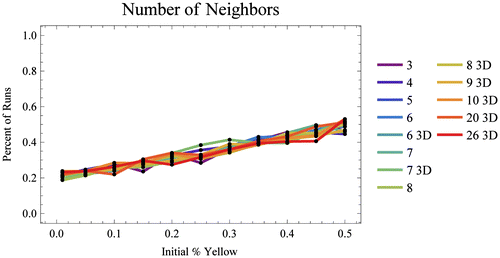
Consistency check bias
One may assume that previously held ideas are less likely to change, and that agents will more likely become consistent by changing newly acquired beliefs to agree with them (Prislin, Citation1996). Or, conversely, one may postulte that since the person has just changed the belief, it will be more salient and more strongly held, and therefore old beliefs will fall in line with the new idea more often than newly changed beliefs will revert to old ones (Crano, Citation1977). We test both of these hypotheses by introducing a parameter for the consistency-check-bias: .5 means no bias, 1.0 means new beliefs are always kept (progressive bias), and .0 means previously-held beliefs are always retained (conservative bias). If both attributes are new, or both equal to their previous values, then the one that is changed is selected in an unbiased way with probability .5. We also test intermediate values to test sensitivity as seen in Figure . Results indicate that setting the value to zero is similar to turning off the consistency check rule and social change is impossible, but the results are otherwise robust to the bias even with probabilities as low as 5%.
Figure 11. Biases in favor in retaining either previously held vs. newly acquired attitudes affect the indirect minority influence on social change.
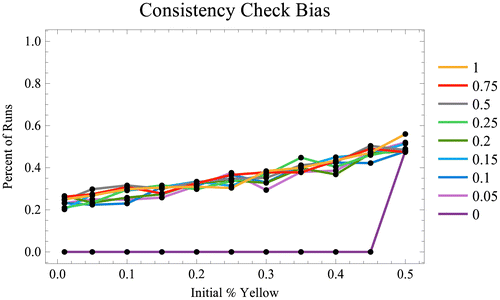
Probability of minority influence
We have shown that minority influence is necessary for social change (along with majority influence and self-consistency), and here we address how strongly the force of minority influence has to be. We do this by reducing the probability of minority influence from 1.0 to various lower levels. Figure shows that drops in the probability of minority influence produce disproportionate drops in the likelihood of social change, but these effects are not nearly as sensitive as those resulting from the cognitive rebalancing.
Figure 12. Decreasing the probability (and hence rate) of minority influence events reduces the incidence of social influence.
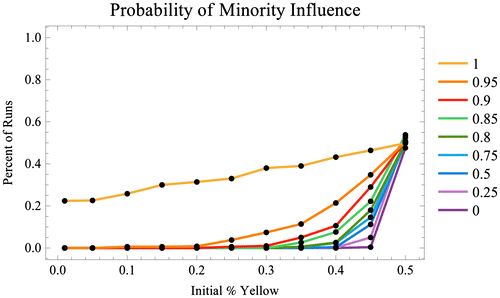
Asynchronous updating
All the simulations discussed were performed via simultaneous updating, and for all the rule combinations the aggregate behavior is indistinguishable except for the case when all three are activated. Social change is still possible with asynchronous updating, but it is much less frequent for any given initial number of yellow agents, and partial social change is markedly less prolonged.
Discussion
Indirect minority influence is a well-studied topic in social psychology. Due to the limitations of empirical methodologies, however, theories and empirical research focus mainly on explicating interpersonal and intra-individual psychological processes of social influence. Whether and how such processes lead to larger level societal phenomena such as social change cannot be directly tested with the usual methods. Most of the claims linking interpersonal/intra-individual-level rules and society-level patterns are merely conjectures. The present study is a beginning attempt to provide a detailed connection between indirect minority influence at a local ingroup level and social change at a large society level through simulation.
We implemented three key social influence mechanisms: direct majority influence, indirect minority influence, and cognitive rebalancing. Results revealed that facing direct majority influence, social change can occur via indirect minority influence in combination with cognitive rebalancing. Even when the system eventually converges to the initial majority position, there are always some periods in which the initially minority position gains majority status. A key difference of our model compared to other cellular automata models of social change is that in our model social change emerges solely from the intrinsic dynamics of social influence. In previous models (Nettle, Citation1999; Nowak & Lewenstein, Citation1996), an exogenous preference toward the initial minority position is necessary for social change.
In the absence of direct majority influence, we also found that indirect minority influence (alone and/or with cognitive rebalancing) always brought the nascent idea up to 50% of the population. After the initially minority idea was no longer the minority idea, the indirect minority process always promoted the less popular idea and contributed to the diversity of different ideas in both local ingroups and the whole society. This connection between indirect minority influence and society’s attitudinal diversity has not been recognized or documented in previous social psychological literature because in empirical settings, it is impossible to isolate the consequences of indirect minority influence from other factors. The capability to isolate cause/effect relationships of proposed mechanisms counts as another benefit of computational modeling.
Another result worth highlighting is that when only majority and minority influence are activated, the final state of agents is always cognitively balanced (blue square) when the system converges. This happens even though the cognitive rebalancing process is turned off; it does not happen when majority influence alone is operating. This result implies that a society coming to have a consistent set of beliefs (cultural formation) need not be the result of any tendency toward cognitive rebalancing. This also implies that although indirect minority influence can facilitate a high level of diversity in some contexts, it may instead contribute to the formation of a system-wide monoculture when combined with other psychological processes. However, when the cognitive rebalancing process is strong, the society increases in diversity of attitudes and probability of social change. This shows that it is necessary to model all these process simultaneously in an integrated platform, rather than separately.
Through the exploration of model parameters, we find that the likelihood of social change most strongly depends on the initial proportion of nascent idea holders. They have a nearly linear relationship in aggregate over hundreds of simulations despite extreme volatility in the system behavior over time for any given run. Surprisingly, ingroup size and the initial distribution of the minority belief holders did not affect the relationship between indirect minority influence and social change.
Various rights movements by American minorities (from abolition through women’s suffrage to the civil rights movement) can be partially understood through our approach. Although they were radical movements, many moderate activists used nonviolent protests and civil disobedience to effect change. Because of the leniency contract, majority Americans would listen to these unthreatening minority voices without derogation or counter-argumentation. Though their focal attitude toward the minority’s rights would not change immediately, they might change on related issues, which might eventually lead to the later success of the movement.
Our goal in this research was to present a minimalist model capable of embodying the mechanisms of majority and minority influence as described in the social psychological literature, and to test its robustness against several theoretical and methodological modifications. These theories, however, are purported to have much wider and deeper application. To fully engage the literature, expansions must be made to both the simulations and the theories. Model expansions should incorporate features such as (a) attitude strength; (b) agents with public and private attitudes on the same issue; (c) intergroup level influence; (d) agents with more attitudes and more variations per attitude; and (e) agents that reproduce, mutate, or undergo selection processes. In some cases these model extensions are further tests of the existing theory, but others require or imply additional theoretical considerations that we pursue in continuing work.
Disclosure statement
No potential conflict of interest was reported by the authors.
Notes
1. Conflict Elaboration Theory (Pérez & Mugny, Citation1996) is another theory that integrates social identity and information processing approaches. The focus of the theory is an issue type (objective and subjective issues) rather than attitude dimensions (focal and related issues).
References
- Abrams, D., & Hogg, M. A. (1990). Social identification, self-categorization and social influence. In W. Stroebe & M. Hewstone (Eds.), European review of social psychology (Vol. 1, pp. 195–228). Chichester: Wiley.
- Abrams, D., & Hogg, M. A. (2010). Social identity and self-categorization. In J. F. Dovidio, M. Hewstone, P. Glick, & V. M. Esses (Eds.), The SAGE handbook of prejudice, stereotyping and discrimination (pp. 179–193). London, UK: SAGE.
- Alvaro, E. M., & Crano, W. D. (1996). Cognitive responses to minority or majority-based communications: Factors that underlie minority influence. British Journal of Social Psychology, 35, 105–121.10.1111/bjso.1996.35.issue-1
- Alvaro, E. M., & Crano, W. D. (1997). Indirect minority influence: Evidence for leniency in source evaluation and counterargumentation. Journal of Personality and Social Psychology, 72, 949–964.10.1037/0022-3514.72.5.949
- Axelrod, R. (1997). The dissemination of culture: A model with local convergence and global polarization. Journal of Conflict Resolution, 41, 203–226.10.1177/0022002797041002001
- Brandstätter, V., Ellemers, N., Gaviria, E., Giosue, F., Huguet, P., Kroon, M., & Perez, J. A. (1991). Indirect majority and minority influence: An exploratory study. European Journal of Social Psychology, 21, 199–211. doi:10.1002/ejsp.2420210303
- Clark, R. D. III. (1990). Minority influence: The role of argument refutation of the majority position and social support for the minority position. European Journal of Social Psychology, 20, 489–497.10.1002/ejsp.v20.6
- Conway, J. H. (1970). The game of life. Scientific American, 223, 120–123.
- Crano, W. D. (1977). Primacy versus recency in retention of information and opinion change. The Journal of Social Psychology, 101, 87–96. doi:10.1080/00224545.1977.9923987
- Crano, W. D. (2001). Social influence, social identity, and ingroup leniency. In C. K. W. de Dreu & N. K. De Vries (Eds.), Group consensus and minority influence: Implications for innovation (pp. 122–143). Oxford: Blackwell.
- Crano, W. D. (2010). Majority and minority influence in attitude formation and change: Context/categorization – Leniency contract theory. In R. Martin & M. Hewstone (Eds.), Minority influence and innovation: Antecedents, processes, and consequences (pp. 53–77). New York, NY: Psychology Press.
- Crano, W. D., & Alvaro, E. M. (1998). Indirect minority influence: The leniency contract revisited. Group Processes & Intergroup Relations, 1, 99–115.10.1177/1368430298012001
- Crano, W. D., & Chen, X. (1998). The leniency contract and persistence of majority and minority influence. Journal of Personality and Social Psychology, 74, 1437–1450.10.1037/0022-3514.74.6.1437
- Crano, W. D., & Lyrintzis, E. (2015). Structure and change of complex political attitudes. In J. P. Forgas, K. Fiedler, & W. D. Crano (Eds.), Social psychology and politics (pp. 21–39). New York, NY: Psychology Press.
- David, B., & Turner, J. C. (2001). Majority and minority influence: A single process. In C. K. W. de Dreu & N. K. De Vries (Eds.), Group consensus and minority influence: Implications for innovation (pp. 91–121). Oxford: Blackwell.
- De Dreu, C. K. W., & De Vries, N. K. (1993). Numerical support, information processing, and attitude change. European Journal of Social Psychology, 23, 647–662. doi:10.1002/ejsp
- De Dreu, C. K. W., & De Vries, N. K. (1996). Differential processing and attitude change following majority versus minority arguments. British Journal of Social Psychology, 35, 77–90. doi:10.1111/j.2044-8309.1996.tb01084.x
- De Vries, N. K., De Dreu, C. K. W., Gordijn, E. H., & Schuurman, M. S. (1996). Majority and minority influence: A dual role interpretation. European Review of Social Psychology, 7, 145–172. doi:10.1080/14792779643000001
- Festinger, L. (1954). A theory of social comparison processes. Human relations, 7, 117–140. doi:10.1177/001872675400700202.
- Festinger, L. (1957). A Theory of cognitivedissonance. Stanford, CA: Stanford University Press.
- Fink, E. L., & Kaplowitz, S. A. (1993). Oscillation in beliefs and cognitive networks. In W. D. Richards Jr & G. A. Barnett (Eds.), Progress in communication sciences (Vol. 12, pp. 247–272). Norwood, NJ: Ablex.
- Galam, S. (2002). Minority opinion spreading in random geometry. The European Physical Journal B – Condensed Matter and Complex Systems, 25, 403–406. doi:10.1140/epjb/e20020045
- Galam, S., & Moscovici, S. (1991). Towards a theory of collective phenomena: Consensus and attitude changes ingroups. European Journal of Social Psychology, 21, 49–74. doi:10.1002/ejsp.2420210105
- Gawronski, B. & Strack, F. (Eds.). (2012). Cognitive consistency: A fundamental principle in social cognition. New York, NY: Guilford Press.
- Gray, K., Rand, D. G., Ert, E., Lewis, K., Hershman, S., & Norton, M. I. (2014). The emergence of ‘us and them’ in 80 lines of code. Psychological Science, 25, 982–990. doi:10.1177/0956797614521816
- Halpern, J. Y., Pass, R., & Seeman, L. (2014). Decision theory with resource-bounded agents. Topics in Cognitive Science, 6, 245–257. doi:10.1111/tops.12088
- Hastie, R., & Stasser, G. (2000). Computer simulation methods for social psychology. In H. T. Reis & C. M. Judd (Eds.), Handbook of research methods in social and personality psychology (pp. 85–116). New York, NY: Cambridge University Press.
- Holland, J. H. (2006). Studying complex adaptive systems. Journal of Systems Science and Complexity, 19, 1–8. doi:10.1007/s11424-006-0001-z
- Jackson, J. C., Rand, D., Lewis, K., Norton, M. I., & Gray, K. (2017). Agent-based modeling: A guide for social psychologists. Social Psychological and Personality Science, 8, 387–395. doi:10.1177/1948550617691100
- Jarman, M., Nowak, A., Borkowski, W., Serfass, D., Wong, A., & Vallacher, R. (2015). The critical few: Anticonformists at the crossroads of minority opinion survival and collapse. Journal of Artificial Societies and Social Simulation, 18, 6.10.18564/jasss.2663
- Judd, C. M., Drake, R. A., Downing, J. W., & Krosnick, J. A. (1991). Some dynamic properties of attitude structures: Context-induced response facilitation and polarization. Journal of Personality and Social Psychology, 60, 193–202.10.1037/0022-3514.60.2.193
- Kerr, N. L., Stasser, G., & Davis, J. H. (1979). Model testing, model fitting, and social decision schemes. Organizational Behavior and Human Performance, 23, 399–410.10.1016/0030-5073(79)90006-0
- Larson, J. R. (1997). Modeling the entry of shared and unshared information into group discussion: A review and basic language Computer Program. Small Group Research, 28, 454–479. doi:10.1177/1046496497283007
- Levine, J. M., & Tindale, R. S. (2015). Social influence in groups. In M. Mikulincer, P. R. Shaver, J. F. Dovidio, & J. A. Simpson (Eds.), APA handbook of personality and social psychology, Vol. 2: Group processes (pp. 3–34). Washington, DC: American Psychological Association. doi:10.1037/14342-001
- Luhmann, C. C., & Rajaram, S. (2015). Memory transmission in small groups and large networks: An agent-based model. Psychological Science, 26, 1909–1917. doi:10.1177/0956797615605798
- MacCoun, R. J. (2012). The burden of social proof: Shared thresholds and social influence. Psychological Review, 119, 345–372. doi:10.1037/a0027121
- Martin, R., & Hewstone, M. (2001). Determinants and consequences of cognitive processes in majority and minority influence. In J. P. Forgas & K. D. Williams (Eds.), Social influence: Direct and indirect processes (pp. 315–330). New York, NY: Psychology Press.
- Martin, R., & Hewstone, M. (2008). Majority versus minority influence, message processing, and attitude change: The source-context-elaboration model. In M. P. Zanna (Ed.), Advances in experimental social psychology (Vol. 40, pp. 237–326). San Diego, CA: Elsevier. doi:10.1016/S00652601(07)00005-6
- Martin, R. & Hewstone, M. (Eds.). (2010). Minority influence and innovation: Antecedents, processes and consequences. Hove: Psychology Press.
- Mason, W. A., Conrey, F. R., & Smith, E. R. (2007). Situating social influence processes: Dynamic, Multidirectional Flows of influence within social networks. Personality and Social Psychology Review, 11, 279–300. doi:10.1177/1088868307301032
- McGuire, W. J. (1990). Dynamic operations of thought systems. American Psychologist, 45(4), 504–512.10.1037/0003-066X.45.4.504
- McGuire, W. J., & McGuire, C. V. (1991). The content, structure, and operation of thought systems. In R. S. Wyer & T. Srull (Eds.), Advances in social cognition (Vol. 4, pp. 1–78). Hillsdale, NJ: Erlbaum.
- Miller, J. H., & Page, S. E. (2007). Complex adaptive systems: An introduction to computational models of social life. Princeton, NJ: Princeton University Press.
- Monroe, B. M., & Read, S. J. (2008). A general connectionist model of attitude structure and change: The ACS (Attitudes as Constraint Satisfaction) model. Psychological Review, 115, 733–759. doi:10.1037/0033-295X.115.3.73
- Moscovici, S. (1976). Social influence and social change. New York, NY: Academic Press.
- Moscovici, S. (1980). Toward a theory of conversion behavior. In L. Berkowitz (Ed.), Advances in experimental social psychology (Vol. 13, pp. 209–239). New York, NY: Academic Press.
- Moscovici, S. (1985). Innovation and minority influence. In S. Moscovici, G. Mugny, & E. van Avermaet (Eds.), Perspectives on minority influence (pp. 9–52). Cambridge, UK: Cambridge University Press.10.1017/CBO9780511897566
- Moscovici, S., & Faucheux, C. (1972). Social influence, conformity bias, and the study of active minorities. In L. Berkowitz (Ed.), Advances in experimental social psychology (Vol. 6, pp. 149–202). New York: Academic Press.
- Moscovici, S., Lage, E., & Naffrechoux, M. (1969). Influence of a consistent minority on the responses of a majority in a color perception task. Sociometry, 32, 365–379.10.2307/2786541
- Nemeth, C. J. (1986). Differential contributions of majority and minority influence. Psychological Review, 93, 23–32. doi:10.1037/0033-295X.93.1.23
- Nettle, D. (1999). Using social impact theory to simulate language change. Lingua, 108, 95–117. doi:10.1016/S0024-3841(98)00046-1
- Nowak, A., & Lewenstein, M. (1996). Modelling social change with cellular automata. In R. Hegselmann, U. Mueller, & K. G. Troitzsch (Eds.), Modelling and simulation in the social sciences from the philosophy of science point of view (pp. 249–285). Netherlands: Kluwer Academic Publishers.10.1007/978-94-015-8686-3
- Nowak, A., Szamrej, J., & Latané, B. (1990). From private attitude to public opinion: A dynamic theory of social impact. Psychological Review, 97, 362–376.10.1037/0033-295X.97.3.362
- Pérez, J. A., & Mugny, G. (1996). The conflict elaboration theory of social influence. In E. H. Witte & J. H. Davis (Eds.), Understanding group behavior: Small group processes and interpersonal relations (Vol. 2, pp. 191–210). Mahwah, NJ: Erlbaum.
- Prislin, R. (1996). Attitude stability and attitude strength: One is enough to make it stable. European Journal of Social Psychology, 26, 447–477. doi:10.1002/(SICI)1099-0992(199605)26:3<447::AID-EJSP768>3.0.CO;2-I
- Prislin, R., & Crano, W. D. (2012). A history of social influence research. In A. W. Kruglanski & W. Stroebe (Eds.), Handbook of the history of social psychology (pp. 321–339). New York, NY: Psychology Press.
- Pulick, E., Korth, P., Grim, P., & Jung, J. (2016). Modeling interaction effects in polarization: Individual media influence and the impact of town meetings. Journal of Artificial Societies and Social Simulation, 19(2), 1. doi:10.18564/jasss.3021 http://jasss.soc.surrey.ac.uk/19/2/1.html
- Read, S. J. & Miller, L. C. (Eds.). (1998). Connectionist models of social reasoning and social behavior. Mahwah, NJ: Lawrence Erlbaum Associates Inc.
- Ron, S. (2006). Cognition and multi-agent interaction: From cognitive modeling to social simulation. New York: Cambridge University Press.
- Schelling, T. C. (1971). Dynamic Models of Segregation. The Journal of Mathematical Sociology, 1, 143–186. doi:10.1080/0022250x.1971.9989794
- Smaldino, P., Pickett, C., Sherman, J., & Schank, J. (2012). An agent-based model of social identity dynamics. Journal of Artificial Societies and Social Simulation, 15, 7. doi:10.18564/jasss.203 http://jasss.soc.surrey.ac.uk/15/4/7.html
- Smith, E. R., & Conrey, F. R. (2007). Agent-based modeling: A new approach for theory building in social psychology. Personality and Social Psychology Review, 11, 87–104. doi:10.1177/1088868306294789
- Stasser, G. (1988). Computer simulation as a research tool: The DISCUSS model of group decision making. Journal of Experimental Social Psychology, 24, 393–422.10.1016/0022-1031(88)90028-5
- Stasser, G. (1999). A primer of social decision scheme theory: Models of group influence, competitive model-testing, and prospective modeling. Organizational Behavior and Human Decision Processes, 80, 3–20.10.1006/obhd.1999.2851
- Stasser, G., Kerr, N. L., & Davis, J. H. (1980). Influence processes in decision-making: A modeling approach. In P. Paulus (Ed.), Psychology of group influence (pp. 431–477). Hillsdale, NJ: Lawrence Erlbaum.
- Stasser, G., & Taylor, L. A. (1991). Speaking turns in face-to-face discussions. Journal of Personality and Social Psychology, 60, 675–684. doi:10.1037/0022-3514.60.5.675
- Vallacher, R., Coleman, P., Nowak, A., & Bui-Wrzosinska, L. (2010). Rethinking intractable conflict: The perspective of dynamical systems. American Psychologist, 65, 262–278.10.1037/a0019290
- Vallacher, R. R., & Nowak, A. (1997). The emergence of dynamical social psychology. Psychological Inquiry, 8, 73–99.10.1207/s15327965pli0802_1
- Vallacher, R. R., & Nowak, A. (2007). Dynamical social psychology: Finding order in the flow of human experience. In A. W. Kruglanski & E. T. Higgins (Eds.), Social psychology: Handbook of basic principles (2nd ed., pp. 734–758). New York, NY: Guilford Publications.
- Vallacher, R. R., Read, S. J., & Nowak, A. (2002). The dynamical perspective in personality and social psychology. Personality and Social Psychology Review, 6, 264–273.10.1207/S15327957PSPR0604_01
- von Neumann, J. (1966). Theory of self-reproducing automata. (A. W. Burkes, Ed.. Urbana: University of Illinois Press.
- Wood, W., Lundgren, S., Ouellette, J. A., Busceme, S., & Blackstone, T. (1994). Minority influence: A meta-analytic review of social influence processes. Psychological Bulletin, 115, 323–345.10.1037/0033-2909.115.3.323

